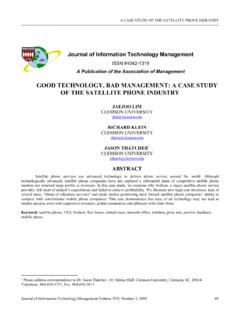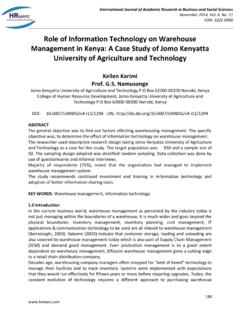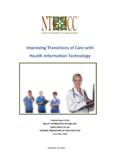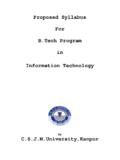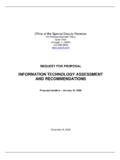Transcription of DEVELOPING INFORMATION TECHNOLOGY …
1 DEVELOPING INFORMATION TECHNOLOGY strategy FOR BUSINESS VALUE Journal of INFORMATION TECHNOLOGY Management Volume XVIII, Number1, 2007 49 Journal of INFORMATION TECHNOLOGY Management ISSN #1042-1319 A Publication of the Association of Management DEVELOPING INFORMATION TECHNOLOGY strategy FOR BUSINESS VALUE HEATHER A. SMITH QUEEN S SCHOOL OF BUSINESS, QUEEN S UNIVERSITY, KINGSTON, ON, CANADA JAMES D. MCKEEN QUEEN S SCHOOL OF BUSINESS, QUEEN S UNIVERSITY, KINGSTON, ON, CANADA SATYENDRA SINGH QUEEN S SCHOOL OF BUSINESS, QUEEN S UNIVERSITY, KINGSTON, ON, CANADA ABSTRACT DEVELOPING INFORMATION TECHNOLOGY (IT) strategy that supports and is supported by business strategy is critical for generating business value in today s organizations. In the face of rapidly changing business conditions and continuously evolving IT, however, organizations have yet to learn how to develop an effective IT strategy . To explore and understand the issue, we conducted a research using focus group methodology.
2 The results from our research suggest that there are five critical success factors that organizations must consider. The research also identifies five practices and the challenges faced while DEVELOPING an effective IT strategy . Keywords: strategy development, IT strategy , IT alignment, IT planning, focus group INTRODUCTION Despite the ongoing debate about the strategic value of INFORMATION TECHNOLOGY (IT) [ , 4, 21, 23], the role of IT within organizations is evolving. Instead of being relegated to the backrooms of the enterprise, IT is now being invited to the boardrooms and is being expected to play a leading role in delivering top line value and business transformation [34]. Weiss and Anderson [37] in their research found that increasingly CIOs and IT professionals are assuming change and risk management roles. They are facing both internal and external pressures to solve both business and technical problems.
3 Gottshalk [13] found similar results too that IT leaders are assuming significant organizational roles including the role of a change leader and having the responsibility for strategic alignment of IT and business. With this augmentation in the critical responsibilities of IT s role, it can no longer be assumed that business strategy will naturally drive IT strategy as has traditionally been the case. Instead, different approaches to strategy development are desirable. The capabilities of emerging IT shape the strategic direction of a firm ( , e-business, wireless). It enables new competencies that make new business strategies possible ( , just-in-time DEVELOPING INFORMATION TECHNOLOGY strategy FOR BUSINESS VALUE Journal of INFORMATION TECHNOLOGY Management Volume XVIII, Number1, 2007 50inventory). It allows new business governance options for how a firm works with other firms. ( , Wal-Mart or Dell Computer).
4 However, whichever way IT strategy is developed, if IT is to deliver business value, IT strategy and business value must always be closely linked [2, 8]. For CIOs and other executives, it is one of the top business concern [19]. Ideally, therefore IT and business strategies should complement and support each other relative to the business environment. strategy development should be a two-way process between IT and business. However, we have yet to learn how to do this. For instance, both in the alignment and the planning literatures we still see the evidence that achieving an effective alignment between IT and business strategies and doing an effective IT planning remain perennial problems [11, 16, 20, 27]. Research has already identified many organizational challenges to effective IT strategy development. If organizations strategy development processes are not compatible ( , if they take place at different times or involve different levels of business), it is unlikely that business and IT will be working towards the same goals at the same time [11].
5 With IT becoming so much more central to the development and delivery of business strategy , much more attention needs to be paid to IT strategy development than it has been paid in the past. What businesses want to accomplish with their IT and how IT shapes its own delivery strategy is increasingly vital to the success of an organization. To explore how organizations are working to improve IT strategy development, the authors convened a focus group of senior IT managers from a variety of industries. This paper first describes the focus group methodology used in this research. Then, it looks at how our understanding of IT strategy has changed over time. Next, it discusses some critical success factors for IT strategy development, followed by how some organizations are beginning to evolve a more formal IT strategy development process. Finally, the paper examines some of the challenges organizations are facing in DEVELOPING an effective IT strategy .
6 RESEARCH METHODOLOGY Due to the exploratory nature of this research we decided to use focus group methodology. While focus group methodology can be used for both exploratory and confirmatory research [32], it is particularly well suited for exploratory research. The methodology is widely employed in various disciplines as a qualitative research technique [22]. It entails a process of obtaining possible ideas or solutions to a problem from a group of participants by discussing [32]. What constitutes focus group methodology is still debated in the literature but most researchers seem to agree on at least a few characteristics: they should consist of a relatively small group of people (usually 7-12), led by a moderator, discussing a particular topic for 90-120 min [9, ]. The main advantage of the methodology is based on the kind of data it generates. Krippendork [18] differentiates between emic data that which arises in a natural or indigenous form and etic data that which represents the researcher s imposed view of the situation.
7 While pure forms of data are rarely obtained in practice, focus group data is much more emic. As a result, focus groups are extremely useful in obtaining general background INFORMATION about a topic, generating research hypotheses for further research, stimulating new ideas, learning what and why individuals think about the phenomenon of interest, and interpreting previously obtained quantitative results [1, 14]. Senior IT managers from 15 different organizations were invited to attend a full-day focus group. Focus group participants represented consulting, manufacturing, insurance, banking and financial, government, retail, telecommunication, automotive and pharmaceutical institutions. The managers were asked to describe the processes their organization uses to develop their IT strategies. In addition, they were asked to assess the relative importance of the strategic use of IT in their firm, how IT strategy is associated with business strategy and how well senior business managers include IT in the development of their business strategies.
8 The participants were also asked to bring any corporate documents which they considered relevant to the topic. The discussion was moderated by one of the authors while the others recorded the discussion independently. The authors actively pushed for clarification of discussion and prompted participants to share actual experiences of specific events within their organizations in order to make arguments and concepts as concrete as possible. The participants were forthcoming with examples to support their observations of organizational phenomena. The research also relied on data collected from the participating organizations Web sites. Further, while analyzing the data, e-mail and telephone communications were also conducted with a few participants in order to get more details and clarification on some of their responses. Our findings are based on an analysis of the focus group discussion in juxtaposition against the published literature on the topic.
9 Our goal was to let practice inform theory and vice versa. DEVELOPING INFORMATION TECHNOLOGY strategy FOR BUSINESS VALUE Journal of INFORMATION TECHNOLOGY Management Volume XVIII, Number1, 2007 51IT strategy : PAST, PRESENT AND FUTURE At the highest level, a strategy is an approach to doing business [12]. Traditionally, a competitive business strategy has involved performing different activities than competitors or performing similar activities in different ways [24]. Ideally, these activities were difficult or expensive for others to copy and therefore resulted in a long-term competitive advantage [12]. They thus enabled firms to charge a premium for their products and services. In the past, the job of an IT function was to understand the business strategy and then figure out a plan to support it. However, all too often, IT s strategic contribution was inhibited by IT managers limited understanding of business strategy and by business managers poor understanding of IT s potential.
10 Therefore, most formal IT plans were focused on more tactical and tangible line of business needs or opportunities for operational integration rather than on supporting enterprise strategy [3]. And investment opportunities were selected largely on their basis to affect the short-term bottom line rather than on delivering long-term top line business value. As a result, instead of looking for ways to be different, in the last decade, much business strategy became a relentless race to compete on efficiencies with IT as the primary means of doing so [15, 24]. Companies improved INFORMATION processing capabilities were used to drive down transaction costs to near zero, threatening traditional value propositions and shaving profit margins. In the present, IT is leading to considerable disruption as business models in many industries ( , the way companies add value) are under attack by new TECHNOLOGY -enabled approaches to delivering products and services ( , the music industry, book-selling).
